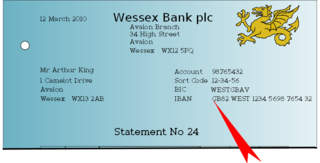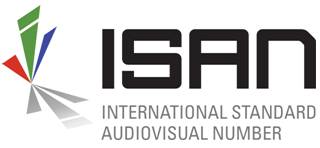A country code is a short alphanumeric identification code for countries and dependent areas. Its primary use is in data processing and communications. Several identification systems have been developed.

The International Standard Book Number (ISBN) is a numeric commercial book identifier that is intended to be unique. Publishers purchase or receive ISBNs from an affiliate of the International ISBN Agency.

The International Bank Account Number (IBAN) is an internationally agreed upon system of identifying bank accounts across national borders to facilitate the communication and processing of cross border transactions with a reduced risk of transcription errors. An IBAN uniquely identifies the account of a customer at a financial institution. It was originally adopted by the European Committee for Banking Standards (ECBS) and since 1997 as the international standard ISO 13616 under the International Organization for Standardization (ISO). The current version is ISO 13616:2020, which indicates the Society for Worldwide Interbank Financial Telecommunication (SWIFT) as the formal registrar. Initially developed to facilitate payments within the European Union, it has been implemented by most European countries and numerous countries in other parts of the world, mainly in the Middle East and the Caribbean. As of July 2023, 86 countries were using the IBAN numbering system.

A vehicle identification number (VIN) (also called a chassis number or frame number) is a unique code, including a serial number, used by the automotive industry to identify individual motor vehicles, towed vehicles, motorcycles, scooters and mopeds, as defined by the International Organization for Standardization in ISO 3779 (content and structure) and ISO 4030 (location and attachment).

An International Standard Serial Number (ISSN) is an eight-digit serial number used to uniquely identify a serial publication, such as a magazine. The ISSN is especially helpful in distinguishing between serials with the same title. ISSNs are used in ordering, cataloging, interlibrary loans, and other practices in connection with serial literature.
An International Securities Identification Number (ISIN) is a code that uniquely identifies a security globally for the purposes of facilitating clearing, reporting and settlement of trades. Its structure is defined in ISO 6166. The ISIN code is a 12-character alphanumeric code that serves for uniform identification of a security through normalization of the assigned National Number, where one exists, at trading and settlement.
The Luhn algorithm or Luhn formula, also known as the "modulus 10" or "mod 10" algorithm, named after its creator, IBM scientist Hans Peter Luhn, is a simple check digit formula used to validate a variety of identification numbers.
In the United States, an ABA routing transit number is a nine-digit code printed on the bottom of checks to identify the financial institution on which it was drawn. The American Bankers Association (ABA) developed the system in 1910 to facilitate the sorting, bundling, and delivering of paper checks to the drawer's bank for debit to the drawer's account.
A CUSIP is a nine-character numeric or alphanumeric code that uniquely identifies a North American financial security for the purposes of facilitating clearing and settlement of trades. All CUSIP identifiers are fungible, which means that a unique CUSIP identifier for each individual security stays the same, regardless of the exchange where the shares were purchased or venue on which the shares were traded. CUSIP was adopted as an American national standard by the Accredited Standards Committee X9 and is designated ANSI X9.6. CUSIP was re-approved as an ANSI standard in December 2020. The acronym derives from Committee on Uniform Security Identification Procedures.
ISO/IEC 7812Identification cards – Identification of issuers is an international standard published jointly by the International Organization for Standardization (ISO) and the International Electrotechnical Commission (IEC). It specifies "a numbering system for the identification of the card issuers, the format of the issuer identification number (IIN) and the primary account number (PAN)", and procedures for registering IINs. It was first published in 1989.

International Standard Audiovisual Number (ISAN) is a unique identifier for audiovisual works and related versions, similar to ISBN for books. It was developed within an ISO TC46/SC9 working group. ISAN is managed and run by ISAN-IA.
The International Standard Recording Code (ISRC) is an international standard code for uniquely identifying sound recordings and music video recordings. The code was developed by the recording industry in conjunction with the ISO technical committee 46, subcommittee 9, which codified the standard as ISO 3901 in 1986, and updated it in 2001.

ISO 6346 is an international standard covering the coding, identification and marking of intermodal (shipping) containers used within containerized intermodal freight transport by the International Organization for Standardization (ISO). The standard establishes a visual identification system for every container that includes a unique serial number, the owner, a country code, a size, type and equipment category as well as any operational marks. The register of container owners is managed by the International Container Bureau (BIC).

The International Standard Music Number or ISMN is a thirteen-character alphanumeric identifier for printed music developed by ISO.
IPI is a unique identifying number assigned by the CISAC database to each Interested Party in collective rights management. It is used worldwide by more than 120 countries and three million right holders.
The International Standard Text Code (ISTC) is a unique identifier for text-based works. The ISO standard was developed by TC 46/SC 9 and published in March 2009 as ISO 21047:2009. The authority responsible for implementing the standard was assigned to The International ISTC Agency. That Agency ceased operations in 2017. Following a public call for a new organization to support the maintenance and registration of ISTC data in which no other organizations stepped forward, and a subsequent report produced by ISO TC 46/SC 9 on text identification, the ISTC standard was withdrawn from the ISO catalogue of standards in August 2021.
The UPU S10 standard defines a system for assigning 13-character identifiers to international postal items for the purpose of tracking and tracing them during shipping.
The Global Release Identifier (GRid) is a system to identify releases of digital sound recordings for electronic distribution. It is designed to be integrated with identification systems deployed by key stakeholders from across the music industry.
A payment card number, primary account number (PAN), or simply a card number, is the card identifier found on payment cards, such as credit cards and debit cards, as well as stored-value cards, gift cards and other similar cards. In some situations the card number is referred to as a bank card number. The card number is primarily a card identifier and may not directly identify the bank account number/s to which the card is/are linked by the issuing entity. The card number prefix identifies the issuer of the card, and the digits that follow are used by the issuing entity to identify the cardholder as a customer and which is then associated by the issuing entity with the customer's designated bank accounts. In the case of stored-value type cards, the association with a particular customer is only made if the prepaid card is reloadable. Card numbers are allocated in accordance with ISO/IEC 7812. The card number is typically embossed on the front of a payment card, and is encoded on the magnetic stripe and chip, but may also be imprinted on the back of the card.

The International Standard Name Identifier (ISNI) is an identifier system for uniquely identifying the public identities of contributors to media content such as books, television programmes, and newspaper articles. Such an identifier consists of 16 digits. It can optionally be displayed as divided into four blocks.














